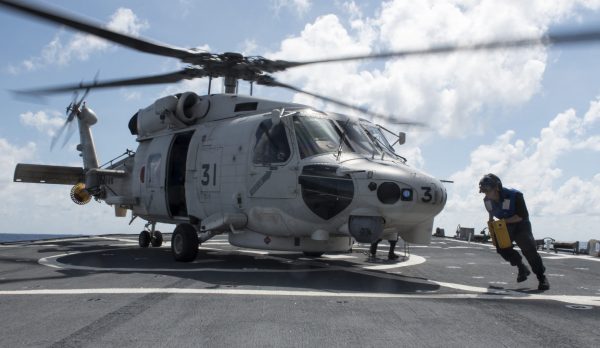ADMM+ comprises the ten ASEAN member countries and Australia, China, India, Japan, New Zealand, Russia, South Korea and the United States. ADMM+ efforts have progressed further and deeper than anything the region has previously experienced. While ADMM+ was initiated as a triennial event, after meetings in 2010 and 2013 it was ‘upgraded’ to a biennial gathering. Some member countries reportedly favour making ADMM+ an annual affair.
ADMM+ has conducted a total of 12 exercises in the seven designated areas of cooperation: counterterrorism, cyber security, humanitarian assistance and disaster relief, humanitarian mine action, maritime security, military medicine, and peacekeeping. Some field exercises have been huge and complex affairs. For example, a combined maritime security and counterterrorism exercise that took place in Brunei and Singapore in May 2016 involved a total of 3,500 personnel, 18 naval vessels, 25 aircraft and 40 special forces teams. All ADMM+ member countries participated in shore-based activities in Brunei, exercises that simulated terrorist attacks at sea between Brunei and Singapore and land-based exercises in north-western Singapore.
Annual leaders’ retreats aimed at facilitating in-depth discussions among ministers have been conducted on a fairly regular basis. While ADMM+ understandably garners all the media attention, the ‘real work’ is left to the ASEAN Defence Senior Officials’ Meeting Plus (ADSOM+) and affiliated working groups. ADSOM+ contributes to setting and implementing the agendas, action plans and joint declarations of defence ministers and receives reports on various cooperative initiatives put forth by ADMM+ members.
ADMM+ stands out as an exception to the rule in a region where form has triumphed over substance in regional security cooperation. ADMM+ reflects what ASEAN and its dialogue partners can achieve so long as the will is there. But as much as the achievements of ADMM+ suggest that ASEAN and its partners could finally be getting security right, their ability to translate these successes into lasting consequences for the region remains to be seen. The prospect of participant fatigue and diminishing returns from commitments to defence cooperation are all too real, particularly if tensions over the South China Sea continue to escalate.
ADMM+ could face a fate similar to that of the ASEAN Regional Forum (ARF) if regional and great powers refuse to exercise mutual restraint in strategic competition. For example, due to intractable differences among its member states, the ADMM+ was forced to scrap a planned joint statement on the South China Sea at its 2015 meeting in Kuala Lumpur.
At the time the media widely but wrongly reported that the failure was reminiscent of the disunity among ASEAN states in Phnom Penh in July 2012 that resulted in ASEAN’s failure to issue a mandatory joint communique. In contrast, all 10 ASEAN members (including the four South China Sea claimant countries — Brunei, Malaysia, the Philippines and Vietnam) jointly rejected the inclusion of the South China Sea in the proposed ADMM+ declaration in 2015.
ADMM+ does not imply the existence of an ASEAN model of defence regionalism. One only need look at the fate of the ARF. After starting brightly and evoking excitement about an ‘Asia Pacific way’ of security cooperation, it fizzled in the heat of opposition among its members to its prospective involvement in preventive diplomacy.
The ARF’s subsequent turn to non-traditional security in the late 2000s made good sense in light of its difficulties. Still, it reflected the indigent state of an institution faced with the ignominy of calls for replacement (such as those made in 2008 by former Australian prime minister Kevin Rudd and in 2009 by former Japanese prime minister Yukio Hatoyama).
Nearly two decades ago, the late Michael Leifer warned against unrealistic expectations of ASEAN-based regionalisms as peacemaking mechanisms, given their evident inability to respond meaningfully to a number of acute problems plaguing the region. Treating ADMM+ as a ‘peace process’ or dispute settlement instrument patently saddles it with unwarranted and impractical expectations. ADMM+ is essentially an ad hoc response aimed at improving the ability of ASEAN countries to handle non-traditional security challenges. Any expectation that it can and should have a key role in conflict management in the South China Sea needs to be critically assessed against its limitations.
Yet it could prove equally premature to outright dismiss the ability of ADMM+ to, under the right conditions, use its extant success and goodwill to improve regional security. Despite its constraints, the ADMM+ should refrain from totally recusing itself from the South China Sea conflicts as the ARF appears to have done.
ADMM+ countries could consider leveraging their mutual goodwill to conduct joint maritime naval exercises in the South China Sea. This is an achievable goal given that the majority of ADMM+ members are signatories to the Code of Unplanned Encounters at Sea established at the Western Pacific Naval Symposium in 2014. ADMM+ still has the potential to stand out from the disappointments of past ASEAN initiatives and contribute substantively to regional defence.
See Seng Tan is Professor of International Relations at the S. Rajaratnam School of International Studies (RSIS), Nanyang Technological University, Singapore and is concurrently Deputy Director and Head of Research of the Institute of Defence and Strategic Studies at RSIS.
This article appeared in the most recent version of East Asia Forum Quarterly, ‘Why ASEAN Matters’.

